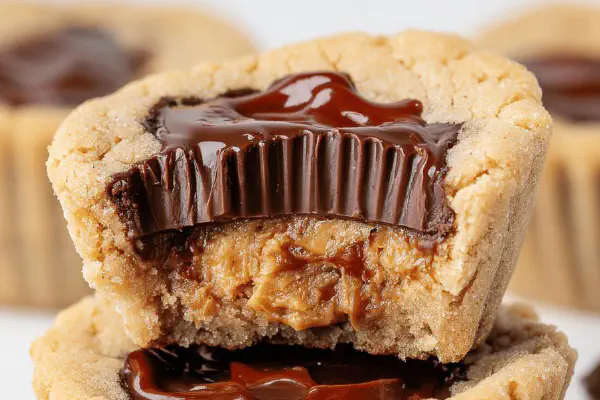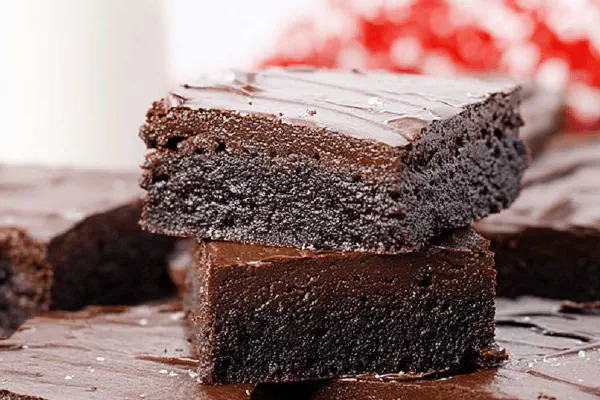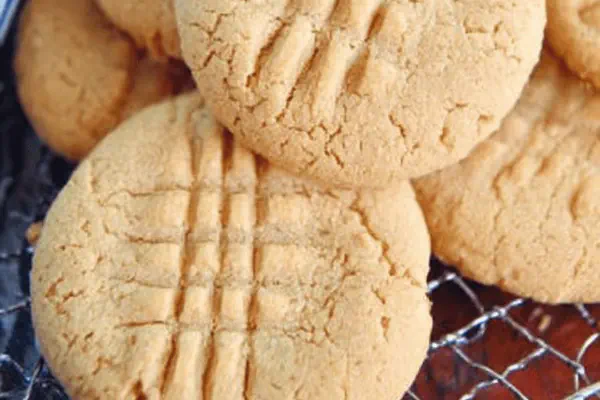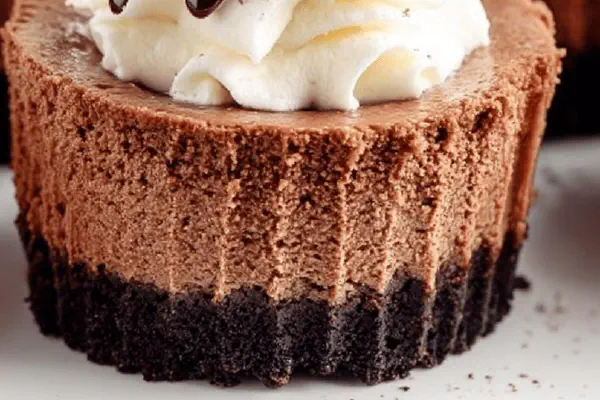Buckeye Cookies Remix
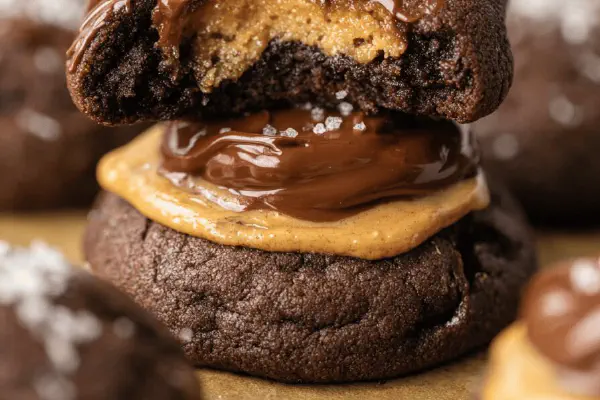
By Emma
Certified Culinary Professional
Ingredients
- 1/2 cup (115g) unsalted butter, softened
- 1/2 cup (130g) creamy peanut butter, not natural style
- 1/4 tsp fine sea salt
- 1 3/4 cups (210g) powdered sugar, sifted
- 1 cup (125g) all-purpose flour
- 1/3 cup (35g) Dutch-processed cocoa powder
- 1/2 tsp instant coffee granules (sub for espresso powder)
- 1 tbsp cornstarch
- 1/2 tsp baking powder
- 1/4 tsp salt
- 4 oz (115g) bittersweet chocolate chips
- 3 tbsp butter
- 1 tsp vanilla extract
- 2 large eggs
- 1/2 cup (100g) granulated sugar
- 1/4 cup (50g) light brown sugar
- 1 tbsp coconut oil
- 4 oz (115g) semisweet chocolate chips
- Flaky sea salt for garnish
About the ingredients
Method
Peanut Butter Layer
- Start by creaming together butter, peanut butter, and salt until creamy but not fluffy. Adding a pinch of salt cuts peanut butter’s natural sweetness.
- Add powdered sugar gradually on low speed to avoid airborne clouds; mixture should be thick and workable, not dry like sand.
- Scoop roughly 1 tablespoon (about 14g) and roll into balls. Press each ball flat into disks—a uniform thickness helps melting and final appearance.
- Lay disks onto parchment-lined plate or sheet. Refrigerate at least 20 minutes; longer chills prevent melting in next steps.
Dry Mix
- Whisk flour, cocoa powder, instant coffee granules, cornstarch, baking powder, and salt in a medium bowl. Coffee heightens chocolate’s complexity, though espresso powder is a fine substitute.
- Whisk lightly but ensure no lumps or clumps.
Chocolate Butter Melt
- Melt chocolate chips and butter in a small saucepan over low to medium-low heat. Stir constantly; the mixture will gloss over and thicken slightly when ready.
- Remove from heat promptly to avoid scorched bitterness. Stir in vanilla extract; aroma should explode—if burnt, start over with fresh batch.
Egg and Sugar Whip
- Use hand or stand mixer with whisk attachment. Beat eggs and sugars for 4-5 minutes till pale, light, and thick—this traps air, giving rise and chew.
- Look for a soft ribbon when you lift the whisk—the color changes from yellow to near white.
Combine Wet and Dry
- Fold cooled chocolate mixture into the egg batter with a rubber spatula. Cause fading color and glossy shine.
- Add dry ingredients in batches; fold deliberately to prevent overworking gluten. Dough should look satiny, slightly shiny, hold shape but tender to touch.
Chill and Shape
- Fridge dough minimum 15 minutes to thicken (this stops spreading during bake). Preheat oven 345°F (instead of 350°F) for gentler rise and to avoid cracking.
- Scoop dough with 2.5 tablespoons or cookie scoop for even sizing. Roll into balls, place on parchment or silicone mat, spaced a bit apart to allow rise.
Bake Cookies
- Bake 12-14 minutes. Cookies should feel set at edges, slightly soft in center, with surface cracked but not dry.
- Remove from oven; cool on sheet 7 minutes before transferring to wire rack—carryover cooking finishes interiors. Avoid moving hot or fragile cookies.
Chocolate Dip
- Melt semisweet chocolate chips and coconut oil in microwave-safe bowl in 30-second intervals, stirring each time until smooth. Coconut oil thins chocolate making dipping easier and adds subtle fragrance.
- If chocolate thickens too much, add teaspoon coconut oil or cocoa butter carefully.
Assemble Final Cookies
- Press chilled peanut butter disks gently onto cooled cookie tops. If disks feel thick or stiff, flatten slightly with fingers so they melt in sync with chocolate dip.
- Spoon melted chocolate over peanut butter layer; do not fully submerge—maintain partial visibility for signature buckeye look.
- Sprinkle flaky sea salt immediately after dipping. The salt heightens contrast, and texture snap. Let chocolate set at room temp till firm.
- Store in cool place, avoid fridge if possible to maintain chew.
Notes
- If peanut butter mixture is too crumbly, add a teaspoon milk or heavy cream to smooth texture. Natural peanut butter can be swapped but expect drier consistency; add extra butter accordingly.
- Watch chocolate melt carefully; overheated chocolate seizes quickly, turning grainy. If that happens, add warm cream spoon by spoon.
- Eggs and sugar whipping step often skipped but crucial. They trap air, lighten texture, prevent heaviness.
- Chilling dough and peanut butter disks is a repeat lesson—museum smooth cookies flop without this patience.
- Pay attention to cookie edges—firm but not hard is the sign, centers slightly soft means chewy insides when cooled.
- Adding instant coffee gives bitter backbone without bitterness.
- Oven temperatures vary; lower temp and longer time preferred here for gentle rise and uniform bake.
Cooking tips
Chef's notes
- 💡 Chill dough always; keeps shape when baking. Warmer dough spreads too much or gets greasy edges. I drop temp low, patient wait. Uniform disks chill best for handling peanut butter spots later on. Cold slows fat melting—no flat disks. Butter must be softened not melted; that texture change makes big difference in creaming and dough feel.
- 💡 Melt chocolate slow in pan over low heat. Stir nonstop. Chocolate should gloss over, thicken but not scorch. Smell matters - burnt means toss batch or restart. Add vanilla right off heat; aroma blooms here, signals done melting step. Too hot kills shine, flavor off balance.
- 💡 Whip eggs and sugars long. Look for pale, light ribbons. Air trapped here gives rise, chew contrast later. Short whipping means dense, heavy cookie. Eyes watch color shifts from smack of yellow to near-white ribbons falling but not disappearing.
- 💡 Folding dry mix into wet is surgical. Gentle lifts only; no stirring or beating or you bloom gluten, tough cookie. Dough looks satiny not rough or crumbly but holds shape. If too thick, chill before shaping. Overmix makes dense slabs; patience in folding gives soft chew.
- 💡 Peanut butter on cookies thick but firm; if disks too soft or thin they melt away once dipped. Flatten disks slightly if very stiff so peanut butter and chocolate layers sync melting temps. Salt sprinkle after chocolate dip sharpens contrasts, bright snap. Skip salt and cookie feels dull, flat inside.
Common questions
Why chill dough so long?
Slows spreading during baking. Warm dough runs fast, flat cookies. Chilling firms fats, sets shape. Makes edges crisp, centers chewy. Plus easier to shape disks. Refrigerators vary temps; adjust times by feel; flick dough, should not stick too much.
What if chocolate seizes when melting?
Happens fast. Overheat or moisture hits. Add spoon warm cream or coconut oil slowly until smooth again. Or toss batch and start fresh. Stirring steady, low heat key. Microwave high heat skips slickness, melts uneven. Watch for matte dullness, then fix quick.
Peanut butter layer too crumbly; what now?
Add teaspoon milk or cream to smooth. Natural peanut butter dries out mix more, skip if flaky brittle disks not wanted. If oils separate, extra butter balances texture but keep chilled after shaping to firm up. Thickness matters here.
How to store finished cookies?
Airtight at room temp best one to two days. Fridge dries them out fast, chew lost. Wrap well if fridge necessary; bring out early to soften before eating. Freeze works okay but chocolate and salt textural contrast dulled when reheated.
